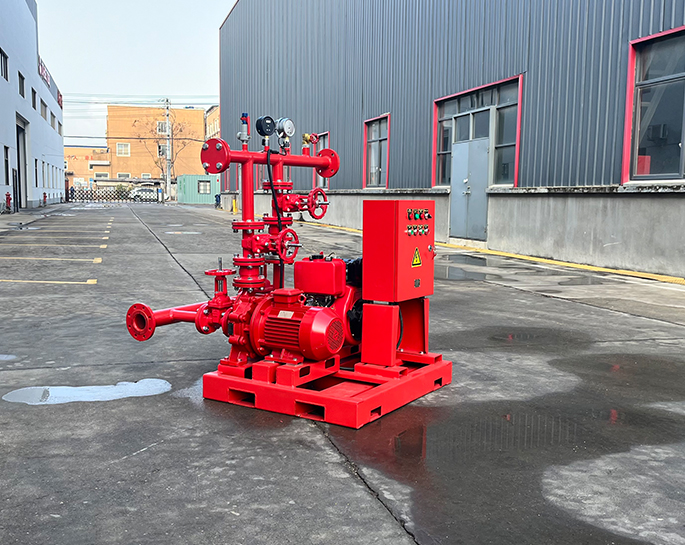What are the key regulatory standards for fire pump installations?
May 20, 2024
Share:
The key regulatory standards for fire pump installations are primarily provided by the National Fire Protection Association (NFPA) and the International Building Code (IBC). These standards ensure that fire pump systems are designed, installed, and maintained to operate effectively during a fire emergency. Here are the main standards:
### NFPA 20: Standard for the Installation of Stationary Pumps for Fire Protection
**NFPA 20** is the primary standard governing the installation of fire pumps. Key aspects include:
- **Pump Types and Applications**: Specifies the types of pumps (e.g., centrifugal, vertical turbine) and their suitable applications.
- **Location and Protection**: Requirements for the placement of fire pumps to ensure accessibility and protection from potential hazards.
- **Power Supplies**: Details on primary and secondary power supplies, ensuring the pump remains operational during power outages.
- **Performance Requirements**: Specifies the performance characteristics, including pressure, flow rates, and reliability.
- **Acceptance Testing**: Mandates acceptance tests to verify proper installation and operation.
- **Maintenance**: Outlines routine inspection, testing, and maintenance procedures to ensure ongoing reliability.
### NFPA 13: Standard for the Installation of Sprinkler Systems
**NFPA 13** includes guidelines relevant to fire pumps used in sprinkler systems:
- **Water Supply Requirements**: Ensures that the fire pump can deliver adequate water supply for the sprinkler system’s operation.
- **System Design Integration**: Integrates fire pump design with the overall sprinkler system to ensure coordinated performance.
### NFPA 25: Standard for the Inspection, Testing, and Maintenance of Water-Based Fire Protection Systems
**NFPA 25** focuses on the ongoing inspection, testing, and maintenance of fire pump systems:
- **Routine Testing**: Requirements for regular operational tests to verify functionality.
- **Maintenance Protocols**: Detailed procedures for maintenance to prevent failures.
- **Record Keeping**: Documentation requirements for inspections, tests, and maintenance activities.
### International Building Code (IBC)
The **IBC** incorporates fire pump requirements as part of its overall building safety codes:
- **Fire Protection Systems**: Requires fire pumps as part of the building’s fire protection infrastructure for certain types of buildings and occupancies.
- **Compliance with NFPA Standards**: Mandates compliance with NFPA standards, particularly NFPA 20.
### Local and Regional Codes
Local and regional codes may have additional or more specific requirements based on geographical and jurisdictional considerations. These codes often reference NFPA standards but may have unique requirements:
- **Local Amendments**: Local fire codes may amend NFPA and IBC standards to address specific local risks or conditions.
- **Inspection and Approval Processes**: Local authorities having jurisdiction (AHJ) typically oversee the inspection and approval of fire pump installations.
### Key Installation Considerations
- **Hydraulic Calculations**: Ensuring that the fire pump’s performance meets the required hydraulic demands of the fire protection system.
- **Environmental Conditions**: Consideration of environmental factors such as seismic activity, temperature, and flooding potential.
- **Coordination with Other Systems**: Ensuring that the fire pump system integrates seamlessly with other fire protection and building systems.
Adhering to these standards and considerations is crucial for ensuring the effectiveness and reliability of fire pump installations in protecting life and property during fire emergencies.

### NFPA 20: Standard for the Installation of Stationary Pumps for Fire Protection
**NFPA 20** is the primary standard governing the installation of fire pumps. Key aspects include:
- **Pump Types and Applications**: Specifies the types of pumps (e.g., centrifugal, vertical turbine) and their suitable applications.
- **Location and Protection**: Requirements for the placement of fire pumps to ensure accessibility and protection from potential hazards.
- **Power Supplies**: Details on primary and secondary power supplies, ensuring the pump remains operational during power outages.
- **Performance Requirements**: Specifies the performance characteristics, including pressure, flow rates, and reliability.
- **Acceptance Testing**: Mandates acceptance tests to verify proper installation and operation.
- **Maintenance**: Outlines routine inspection, testing, and maintenance procedures to ensure ongoing reliability.
### NFPA 13: Standard for the Installation of Sprinkler Systems
**NFPA 13** includes guidelines relevant to fire pumps used in sprinkler systems:
- **Water Supply Requirements**: Ensures that the fire pump can deliver adequate water supply for the sprinkler system’s operation.
- **System Design Integration**: Integrates fire pump design with the overall sprinkler system to ensure coordinated performance.
### NFPA 25: Standard for the Inspection, Testing, and Maintenance of Water-Based Fire Protection Systems
**NFPA 25** focuses on the ongoing inspection, testing, and maintenance of fire pump systems:
- **Routine Testing**: Requirements for regular operational tests to verify functionality.
- **Maintenance Protocols**: Detailed procedures for maintenance to prevent failures.
- **Record Keeping**: Documentation requirements for inspections, tests, and maintenance activities.
### International Building Code (IBC)
The **IBC** incorporates fire pump requirements as part of its overall building safety codes:
- **Fire Protection Systems**: Requires fire pumps as part of the building’s fire protection infrastructure for certain types of buildings and occupancies.
- **Compliance with NFPA Standards**: Mandates compliance with NFPA standards, particularly NFPA 20.
### Local and Regional Codes
Local and regional codes may have additional or more specific requirements based on geographical and jurisdictional considerations. These codes often reference NFPA standards but may have unique requirements:
- **Local Amendments**: Local fire codes may amend NFPA and IBC standards to address specific local risks or conditions.
- **Inspection and Approval Processes**: Local authorities having jurisdiction (AHJ) typically oversee the inspection and approval of fire pump installations.
### Key Installation Considerations
- **Hydraulic Calculations**: Ensuring that the fire pump’s performance meets the required hydraulic demands of the fire protection system.
- **Environmental Conditions**: Consideration of environmental factors such as seismic activity, temperature, and flooding potential.
- **Coordination with Other Systems**: Ensuring that the fire pump system integrates seamlessly with other fire protection and building systems.
Adhering to these standards and considerations is crucial for ensuring the effectiveness and reliability of fire pump installations in protecting life and property during fire emergencies.


.png)
.png)

.png)


